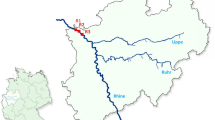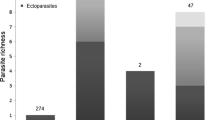Abstract
Several species of European slugs are invasive in the USA, threatening native species and damaging agricultural and horticultural crops. One possible explanation for the success of these invaders is parasite release. To test this hypothesis we collected European slugs in part of their native range (United Kingdom) and in the USA and compared prevalence, distribution and species richness of their nematode parasites. All slugs were dissected and examined for the presence of nematodes. In the UK, nematodes were present at 93% of study sites and 16.4% of all slugs examined were associated with nematodes whereas in the USA the respective figures were 34% of sites and 5.4% of slugs. Nematode species richness was greater in the UK with 12 species being found, seven of which were thought to be truly parasitic as opposed to being phoretic or necromenic. Nine species of nematode were found in the USA, four of which were truly parasitic. Four of the ten European slug species examined in the USA, were entirely free of truly parasitic nematodes whereas all were infected by nematodes in some sites in the UK. There was a significant difference in the prevalence of truly parasitic nematodes in five of these species when comparing their home versus invasive range. A significant difference in parasite prevalence was observed when comparing native and introduced slug species in the USA, however, this was not significant in the UK. Our data support a role for parasite release during the invasion of the USA by European slugs.





Similar content being viewed by others
References
Adams JM, Fang W, Callaway RM, Cipollini D, Newell E (2009) A cross-continental test of the enemy release hypothesis: leaf herbivory on Acer platanoides (L.) is three times lower in North America than in its native Europe. Biol Invasions 11:1005–1016. doi:10.1007/s10530-008-9312-4
Barker GM (2001) The biology of terrestrial molluscs. CABI Publishing, Wallingford
Barker GM (2002) Gastropods as pests in New Zealand pastoral agriculture, with emphasis on Agriolimacidaae and Arionidae and Milacidae. In: Barker GM (ed) Molluscs as crop pests. CABI Publishing, Wallingford, pp 361–423
Blaxter ML, de Ley P, Garey JR, Liu LX, Scheldeman P, Vierstraete A, Vanfleteren JR, Mackey LY, Dorris M, Frisse LM, Vida JT, Thomas WK (1998) A molecular evolutionary framework for the phylum Nematoda. Nature 392:71–75. doi:10.1038/32160
Brady JK, Pearce TA (2007) Terrestrial slugs in strip mined and unmined forested land, Tuscarawas County, Ohio, USA. Proc Acad Nat Sci Phila 156:17–122
Cameron RAD (1986) Environment and diversities of forest snail faunas from coastal British Columbia. Malacologia 27:341–355
Catford JA, Jansson R, Nilsson C (2009) Reducing redundancy in invasion ecology by integrating hypotheses into a single theoretical framework. Divers Distrib 15:22–40. doi:10.1111/j.1472-4642.2008.00521.x
Charwat SM, Davies KA (1999) Laboratory screening of nematodes isolated from South Australia for potential as biocontrol agents of helicid snails. J Invertebr Pathol 74:55–61. doi:10.1006/jipa.1999.4855
Dunn JC, McClymont HE, Christmas M, Dunn AM (2009) Competition and parasitism in the native white clawed crayfish Austropotamobius pallipes and the invasive signal crayfish Pacifastacus leniusculus in the UK. Biol Invasions 11:315–324. doi:10.1007/s10530-008-9249-7
Gaugler R, Campbell JF, Selvan S, Lewis EE (1992) Large-scale inoculative release of entomopathogenic nematodes Steinernam glaseri: assessment 50 years later. Biol Control 2:181–187. doi:10.1016/1049-9644(92)90057-K
Genner MJ, Michel E, Todd JA (2008) Resistance of an invasive gastropod to an indigenous trematode parasite in Lake Malawi. Biol Invasions 10:41–49. doi:10.1007/s10530-007-9105-1
Gleich JG, Gilbert FF, Kutscha NP (1977) Nematodes in terrestrial gastropods from central Maine. J Wildl Dis 13:43–46
Grewal SK, Grewal PS, Hammond RB (2003a) Susceptibility of North American native and non-native slugs (Mollusca: Gastropoda) to Phasmarhabditis hermaphrodita (Nematoda: Rhabditidae). Biocontrol Sci Technol 13:119–125. doi:10.1080/0958315021000054449
Grewal PS, Grewal SK, Tan L, Adams BJ (2003b) Parasitism of molluscs by nematodes: types of associations and evolutionary trends. J Nematol 35:146–156
Hammond RB, Byers RA (2002) Agriolimacidaae and Arionidae as pests in conservation-tillage soybean and maize cropping in North America. In: Barker GM (ed) Molluscs as crop pests. CABI Publishing, Wallingford, pp 301–335
Joe SM, Daehler CC (2008) Invasive slugs as under-appreciated obstacles to rare plant restoration: evidence from the Hawaiian Islands. Biol Invasions 10:245–255. doi:10.1007/s10530-007-9126-9
Keane RM, Crawley MJ (2002) Exotic plant invasions and the enemy release hypothesis. Trends Ecol Evol 17:164–170. doi:10.1016/S0169-5347(02)02499-0
Kerney M (1999) Atlas of the land and freshwater molluscs of Britain and Ireland. Harley Books, Colchester
Kiontke K, Sudhaus W (2006) Ecology of Caenorhabditis sp. In: The C. elegans Research Community (ed) Wormbook. doi:10.1895/wormbook.1.37.1 (http://www.wormbook.org)
Krakau M, Thieltges DW, Reise K (2006) Native parasites adopt introduced bivalves of the North Sea. Biol Invasions 8:919–925. doi:10.1007/s10530-005-4734-8
Mack RN, Simberloff D, Lonsdale WM, Evans H, Clout M, Bazzaz FA (2000) Biotic invasions: causes, epidemiology, global consequences, and control. Ecol Appl 10:689–710. doi:10.1890/1051-0761(2000)010[0689:BICEGC]2.0.CO;2
Marr S, Mautz WJ, Hara AH (2008) Parasite loss and introduced species: a comparison of the parasites of the Puerto Rican tree frog, (Eleutherodactylus coqui), in its native and introduced ranges. Biol Invasions 10:1289–1298. doi:10.1007/s10530-007-9203-0
Maze DM (2009) Effect of terrestrial mollusc herbivory on Holocarpha macradenia (Asteraceae) seedlings in California coastal prairie under different clipping regimes. Madrono (in press)
Mengert H (1953) Nematoden und schnecken. Z Morphol Oekol Tiere 41:311–349. doi:10.1007/BF00407426
Mitchell CE, Power AG (2003) Release of invasive plants from fungal and viral pathogens. Nature 421:625–627. doi:10.1038/nature01317
Morand S (1988) Contribution d’Etude a’un Systeme Hots-Parasites: Nematodes Associes a quelques Mollusques Terrestres. These doctorate, Universite de Rennes, France
Morand S, Wilson MJ, Glen DM (2004) Nematodes (Nematoda) parasitic in terrestrial gastropods. In: Barker GM (ed) Natural enemies of terrestrial molluscs. CABI Publishing, Wallingford, pp 525–557
Parkman JP, Smart GC Jr (1996) Entomopathogenic nematodes, a case study: introduction of Steinernema scapterisci in Florida. Biocontrol Sci Technol 6:413–419. doi:10.1080/09583159631389
Pilsbry HA (1948) Land mollusca of North America (north of Mexico). Acad Nat Sci Phila Mono Ser 3(2):521–1113
Rae RG, Verdun C, Grewal PS, Robertson JF, Wilson MJ (2007) Biological control of terrestrial molluscs using Phasmarhabditis hermaphrodita—progress and prospects. Pest Manag Sci 63:1153–1164. doi:10.1002/ps.1424
Rae RG, Robertson JF, Wilson MJ (2008) Susceptibility and immune response of Deroceras reticulatum, Milax gagates and Limax pseudoflavus exposed to the slug parasitic nematode Phasmarhabditis hermaphrodita. J Invertebr Pathol 97:61–69. doi:10.1016/j.jip.2007.07.004
Raut SK, Barker GM (2002) Achatina fulica Bowdich and other Achatinidae as pests in tropical agriculuture. In: Barker GM (ed) Molluscs as crop pests. CABI Publishing, Wallingford, pp 55–114
Richardson DM, Pysek P (2006) Plant invasions: merging the concepts of species invasiveness and community invasibility. Prog Phys Geogr 30:409–431. doi:10.1191/0309133306pp490pr
Seinhorst JW (1959) A rapid method for the transfer of nematodes from fixative to anhydrous glycerine. Nematologica 4:67–69
Severns PM (2006) Seasonality, habitat preference and life history of some Willamette Valley wet prairie terrestrial molluscs in western Oregon, USA. Veliger 48:220–227
Simberloff D, Gibbons L (2004) Now you see them, now you don’t!—population crashes of established introduced species. Biol Invasions 6:161–172. doi:10.1023/B:BINV.0000022133.49752.46
Torchin ME, Lafferty KD, Dobson AP, McKenzie VJ, Kuris AM (2003) Introduced species and their missing parasites. Nature 421:628–629. doi:10.1038/nature01346
Van der Putten WH, Yeates GW, Duyts H, Reis CS, Karssen G (2005) Invasive plants and their escape from root herbivory: a worldwide comparison of the root-feeding nematode communities of the dune grass Ammophila arenaria in natural and introduced ranges. Biol Invasions 7:733–774. doi:10.1007/s10530-004-1196-3
Vignon M, Sasal P, Galzin R (2009) Host introduction and parasites: a case study on the parasite community of the peacock grouper Cephalopholis argus (Serranidae) in the Hawaiian Islands. Parasitol Res 104:775–782. doi:10.1007/s00436-008-1254-3
Wilson MJ, Glen DM, George SK (1993a) The rhabditid nematode Phasmarhabditis hermaphrodita as a potential biological control agent for slugs. Biocontrol Sci Technol 3:503–511. doi:10.1080/09583159309355306
Wilson MJ, Glen DM, George SK, Butler RC (1993b) Mass cultivation and storage of the rhabditid nematode Phasmarhabditis Hermaphrodita, a biocontrol agent of slugs. Biocontrol Sci Technol 3:513–521. doi:10.1080/09583159309355307
Wilson MJ, Glen DM, George SK, Pearce JD, Wiltshire CW (1994) Biological control of slugs in winter wheat using the rhabditid nematode, Phasmarhabditis hermaphrodita. Ann Appl Biol 125:377–390. doi:10.1111/j.1744-7348.1994.tb04978.x
Wilson MJ, Glen DM, George SK, Hughes LA (1995a) Biocontrol of slugs in protected lettuce using the rhabditid nematode Phasmarhabditis hermaphrodita. Biocontrol Sci Technol 5:233–242. doi:10.1080/09583159550039954
Wilson MJ, Glen DM, Pearce JD, Rodgers PB (1995b) Monoxenic culture of the slug parasite, Phasmarhabditis hermaphrodita with different bacteria in liquid and solid phase. Fundam Appl Nematol 18:159–166
Acknowledgments
This study was supported by Becker Underwood and BBSRC. We would like to thank Steve Booth, Robbie Rae, Don Strong, Maria Tourna and numerous Becker Underwood staff for helping with slug collection. We would also like to acknowledge the referees’ contributions.
Author information
Authors and Affiliations
Corresponding author
Electronic supplementary material
Below is the link to the electronic supplementary material.
Rights and permissions
About this article
Cite this article
Ross, J.L., Ivanova, E.S., Severns, P.M. et al. The role of parasite release in invasion of the USA by European slugs. Biol Invasions 12, 603–610 (2010). https://doi.org/10.1007/s10530-009-9467-7
Received:
Accepted:
Published:
Issue Date:
DOI: https://doi.org/10.1007/s10530-009-9467-7




